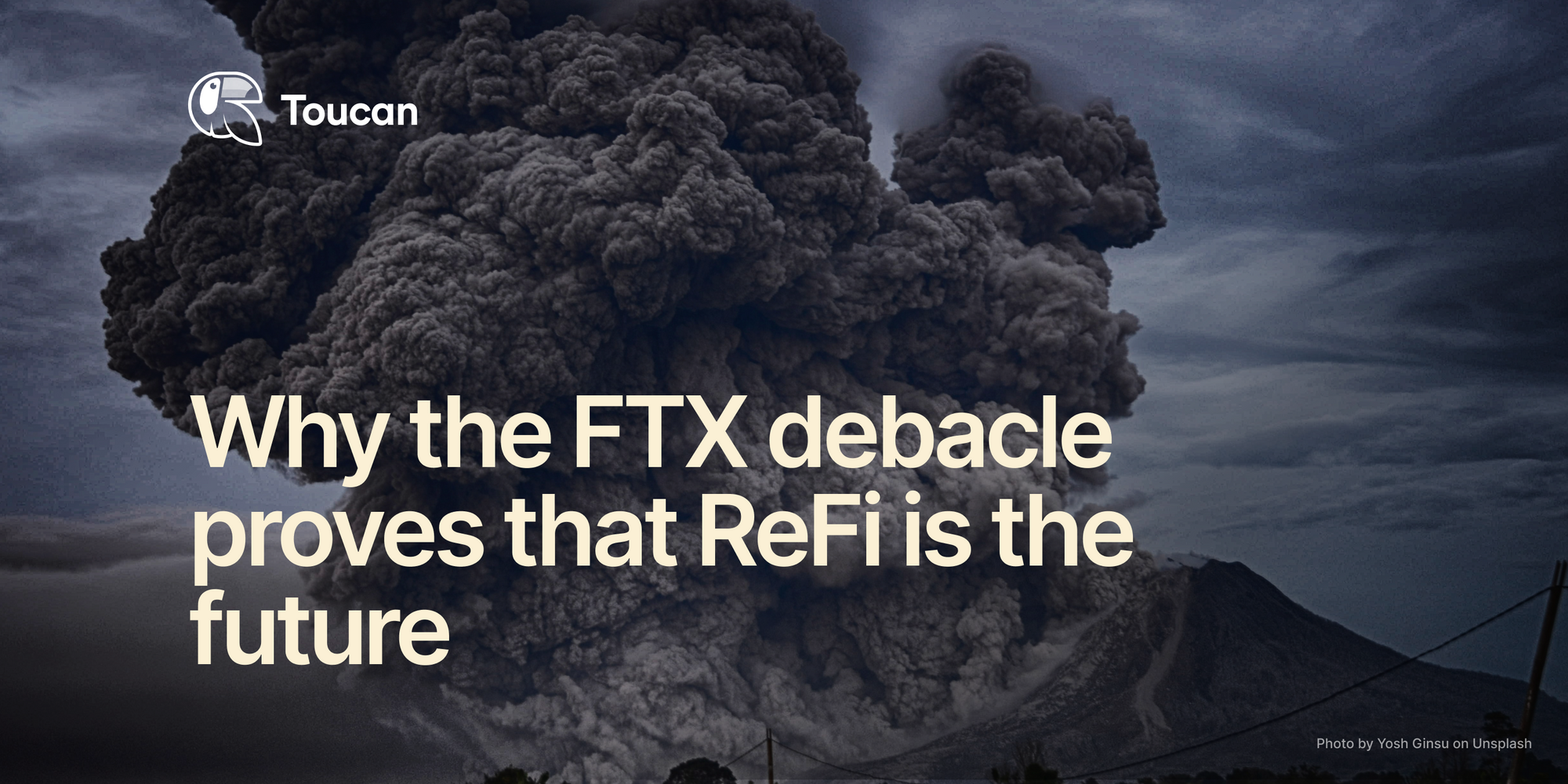Why the FTX debacle proves that DeFi (and ReFi) are the future
The FTX Group has filed for bankruptcy. What implications does this have for the crypto industry and for on-chain carbon? A piece to put the recent events in perspective.

The FTX Group has filed for bankruptcy. What implications does this have for the crypto industry and for on-chain carbon? A short piece to put the recent events in perspective.
What exactly happened?
The third-biggest centralized cryptocurrency exchange, FTX, filed for bankruptcy on November 11, 2022, going from a $32 billion valuation to insolvency within a few days. The person behind FTX is Sam Bankman-Fried, who also founded hedge fund Alameda. What happened in the background: Both entities — FTX and Alameda — were used to strategically prop each other up. A large portion of FTX’s equity was owned by its sister company, Alameda, in the form of FTT (FTX’s token). On top of that, users funds were used in non-transparent and reckless ways.
On November 2, 2022, Web3 news platform Coindesk published an article that pointed out that FTX was being propped up by Alameda. This highlighted that the former was not solvent and the latter extremely exposed, should the value of FTT go down.
Rivaling cryptocurrency exchange, Binance, also owned a large volume of FTT tokens. This new piece of information gave them a reason to sell off their holding and trigger the collapse of their competitor in one fell swoop. And when Binance decided to sell (or ‘dump’) their FTT, they spawned a wave of other token holders to also sell. This massive sell-off crashed the value of both FTX and Alameda in the process.
The interesting thing here: All involved organizations are legitimate and regulated businesses. Their users did not expect any foul play and relied on the assumption that their funds would be used in a sensitive way. And all players are essentially traditional financial institutions operating in the cryptocurrency space, not decentralized, Web3-native protocols.
They were supposed to follow government regulations, and yet they abused their power and directed flows of value to benefit a small number of largely unsupervised individuals.
These recent events — however painful — underpin how strongly we need to value decentralizing control over huge value flows. It also shows that regulators alone cannot be relied upon alone to keep us safe when interacting with financial instruments. Governance should be built into the value chain and coded into smart contracts, instead of applied at the top.
How could this happen?
The CeDeFi industry (centralized financial institutions operating in the decentralized finance space) is notoriously opaque, which creates opportunities for bad actors to abuse the system, or to make independent decisions that might benefit them above all else, i.e. using users funds for risky investments.
In the case of FTX, there was a lack of risk management and compliance, as well as serious conflicts of interest. They were essentially utilizing some of the technology and all the hype of Web3, with none of the values and governance that underpin truly decentralized finance infrastructure.
What impact does this have?
None of the events have any bearing on the on-chain carbon market, the Regenerative Finance space or tokenized carbon credits. All crypto assets held in self-custodial crypto wallets (i.e. Metamask) are totally unaffected as they are controlled by the user, not a third-party exchange. Again, this highlights the value in the Web3 ethos “not your keys, not your coins”.
Will the price of tokenized carbon credits fall?
As tokenized carbon credits are backed by a real-world asset (the original carbon credit), they are less prone to the extreme price volatility that has been seen with other cryptocurrencie s. In the future, we're aiming for a two-way carbon bridge (where carbon credits can be freely moved on-chain and back off-chain at any time). In that scenario, the value of tokenized carbon will map to regular carbon credits, and the markets will be level, because credits aren't siloed in one trading platform.
Why did other cryptocurrencies lose value?
Whether specific cryptocurrencies — or native tokens — go up or down in value is based on their own market or organization’s performance. Something similar is happening with stocks: The current fall in value of Twitter shares is linked to what is happening within the company. But this does not affect other FTSE market companies within different industries, just because they’re floated on the same stock market.
What can we learn from the recent events?
The Web3 space is relatively nascent – and so are open and transparent carbon markets. We can look to the crypto industry and learn from the mistakes and successes of the recent years. A key takeaway from the latest events: We need to avoid putting the power of something that is meant to scale very fast (like our carbon markets) into the hands of a few individual players. This is why we at Toucan are focussed on building a “neutral” infrastructure layer where carbon credits with different attributes and from different registries all follow the same taxonomy, as well as an open registry system that anyone can use.
Toucan is very focused on integrating risk management and compliance in our protocol to support the decentralized finance environment. This mitigates the often impactful decisions of bad actors in centralized platforms, such as CeFi exchanges. Toucan Protocol is project agnostic, and we do not have preferences for any registry or project.
Toucan is building the technology to bring the world's supply of carbon credits onto energy-efficient blockchains and turn them into tokens that anyone can use. This paves the way for a more efficient and scalable global carbon market.

